Determination of Winter Irrigation Quotas for Corn and Oil Sunflower Considering Crop Salt Tolerance Threshold under Subsurface Pipe Drainage Technology
Abstract
:1. Introduction
2. Materials and Methods
2.1. Indoor Soil Tank Test of Subsurface Pipe Drainage
2.1.1. Test Materials and Treatment
- (1)
- Test materials
- (2)
- Test treatment
- (3)
- Test procedure
2.1.2. Test Indicators
2.2. Construction and Verification of Numerical Simulation Model of Subsurface Pipe Drainage
2.2.1. Basic Principles of the Model
- (1)
- Soil water transport model
- (2)
- Soil solute transport model
2.2.2. Model Establishment
2.2.3. Soil Hydraulic Characteristics
2.2.4. Model Validation
2.3. Numerical Simulation Test
2.3.1. Simulation Test Design
2.3.2. Determination Conditions of Suitable Winter Irrigation Quotas
2.4. Data Analysis
3. Results
3.1. Verification of HYDRUS-2D Model for Subsurface Drainage
3.2. The Change Rule of Soil Desalination Rate above the Subsurface Pipe
3.3. Spatial Variation of Soil Desalination Rate
3.4. Subsurface Pipe Drainage Leaching Standard Proportion Coefficient
3.5. The Appropriate Amount of Water for Flushing in Subsurface Pipe Drainage
4. Discussion
4.1. Desalination Rate of Soil above the Subsurface Pipe after Irrigation
4.2. Spatial Distribution of Soil Desalination Rate after Irrigation
4.3. Suitable Winter Irrigation Quotas under Different Saline–Alkali Degree and Soil Texture Conditions
5. Conclusions and Suggestions
- (1)
- The normalized root mean square error (nRMSE) between the simulated value and the measured value above the subsurface pipe is less than 20%, and the nRMSE below the subsurface pipe is less than 25%.
- (2)
- The soil desalination rate above the subsurface pipe increased with the initial soil salt content and the winter irrigation quota, but the rate of increase gradually decreased. The soil desalination of clay loam and silty loam with small soil particle gap is better than that of loam and sandy loam. The soil desalination rate decreases as the distance from the subsurface pipe increases, and it also decreases with increasing soil depth. There is desalination occurring in the soil from 0–10 cm below the subsurface pipe, and salt accumulation occurs at 20–25 cm below the subsurface pipe.
- (3)
- Taking into account factors such as crop salt tolerance threshold and standard leaching ratio coefficient η, the four soil types with mild salinization (salt content ≤ 3 g/kg) are suitable for the planting of corn, and the recommended winter irrigation quota is 80 mm. The silty loam with severe salinization (salt content ≥ 5 g/kg) is suitable for the planting of oil sunflower, and the recommended winter irrigation quota is 80 mm. For the four soil types with moderate salinization (salt content of 3–5 g/kg), the planting mode of oil sunflower–corn intercropping is recommended, and the recommended winter irrigation quota is 120 mm.
- (4)
- For loam, sandy loam, and clay loam with severe salinization (salt content ≥ 5 g/kg), it is suggested to increase other measures to reduce soil salt content, such as reducing the spacing and burial depth of subsurface pipes, applying desulfurization gypsum and biochar, and deep tillage.
Author Contributions
Funding
Data Availability Statement
Conflicts of Interest
References
- Chen, J. Analysis of regional coordinated development in Ningxia. China Natl. Cond. Natl. Strength 2021, 5, 64–67. (In Chinese) [Google Scholar]
- Guo, J.; Wang, M.; Geng, R.; Li, X.; Yin, X.; Wei, G. Analysis on salinization characteristics of saline-alkali land in Yinbei irrigation area of Ningxia. Chin. Agric. Sci. Bull. 2021, 37, 38–42. (In Chinese) [Google Scholar]
- Tan, P.; Wang, S.; Fu, T.; Liu, J.; Han, L. Development history, current situation and prospect of subsurface pipe drainage technology in China. Chin. J. Eco-Agric. 2021, 29, 633–639. (In Chinese) [Google Scholar]
- Wang, S.; Li, Y.; Tao, Y.; Li, J.; Tian, J. Solar photovoltaic subsurface pipe drainage system capacity improvement. Agric. Eng. 2022, 38, 99–104. (In Chinese) [Google Scholar]
- Liu, H.; Ju, W.; Shao, M.; Hou, L. Investigation of Salt and Nitrogen Distribution under Belt Plastic Film Mulching in Surface-and Drip-Irrigated Maize Field in Hetao Irrigation District. Water 2023, 15, 2755. [Google Scholar] [CrossRef]
- Yasmeen, R.; Hao, G.; Ye, Y.; Shah, W.U.H.; Tang, C. The Synergy of Water Resource Agglomeration and Innovative Conservation Technologies on Provincial and Regional Water Usage Efficiency in China: A Super SBM-DEA Approach. Water 2023, 15, 3524. [Google Scholar] [CrossRef]
- Chen, S.; Jiang, G. Ecosystem Service Value Response to Different Irrigation and Drainage Practices in a Land Development Project in the Yellow River Delta. Water 2022, 14, 2985. [Google Scholar] [CrossRef]
- Liu, J.; Huang, Q.; Li, Z.; Liu, N.; Li, J.; Huang, G. Effect of Autumn Irrigation on Salt Leaching under Subsurface Drainage in an Arid Irrigation District. Water 2023, 15, 2296. [Google Scholar] [CrossRef]
- Xu, J.; Wang, Y.; Chen, Y.; He, W.; Li, X.; Cui, J. Identifying the Influencing Factors of Plastic Film Mulching on Improving the Yield and Water Use Efficiency of Potato in the Northwest China. Water 2023, 15, 2279. [Google Scholar] [CrossRef]
- Yao, R.; Gao, Q.; Liu, Y.; Li, H.; Yang, J.; Bai, Y.; Zhu, H.; Wang, X.; Xie, W.; Zhang, X. Deep vertical rotary tillage mitigates salinization hazards and shifts microbial community structure in salt-affected anthropogenic-alluvial soil. Soil Tillage Res. 2023, 227, 105627. [Google Scholar] [CrossRef]
- Shen, Q.; Yang, J. Effects of different improvement models on alkaline soil properties and wolfberry yield under drip irrigation conditions. Jiangsu J. Agric. Sci. 2020, 36, 343–349. (In Chinese) [Google Scholar]
- Zhao, Y.; Wang, S.; Li, Y.; Liu, J.; Zhuo, Y.; Zhang, W.; Wang, J.; Xu, L. Long-term performance of flue gas desulfurization gypsum in a large-scale application in a saline-alkali wasteland in northwest China. Agric. Ecosyst. Environ. 2018, 261, 115–124. [Google Scholar] [CrossRef]
- Liang, J.; Shi, W. Cotton/halophytes intercropping decreases salt accumulation and improves soil physicochemical properties and crop productivity in saline-alkali soils under mulched drip irrigation: A three-year field experiment. Field Crops Res. 2021, 262, 108027. [Google Scholar] [CrossRef]
- Li, F.; Guo, Y.; Wang, Z.; Mu, Y. Influence of different phytoremediation on soil microbial diversity and community composition in saline-alkaline land. Int. J. Phytoremediat. 2022, 24, 507–517. [Google Scholar] [CrossRef] [PubMed]
- Feng, G.; Zhang, Z.; Wan, C.; Lu, P.; Ahmad, B. Effects of saline water irrigation on soil salinity and yield of summer corn (Zea mays L.) in subsurface drainage system. Agric. Water Manag. 2017, 193, 205–213. [Google Scholar] [CrossRef]
- Tiwari, P.; Goel, A. An overview of impact of subsurface drainage project studies on salinity management in developing countries. Appl. Water Sci. 2017, 7, 569–580. [Google Scholar] [CrossRef]
- Ren, X.; Wang, S.; Yang, P.; Tao, Y. Simulation test on subsurface drainage effect of different drainage measures in farmland. J. Drain. Irrig. Mach. Eng. 2023, 41, 253–260. (In Chinese) [Google Scholar]
- Zhuang, X.; Feng, S.; Yu, H.; Yuan, C.; Qian, C. SWAP model simulates soil water and salt transport under subsurface drainage conditions. J. Irrig. Drain. 2020, 39, 93–101. (In Chinese) [Google Scholar]
- Zhang, L.; Jiao, P.; Dong, Q.; Tao, Y. The effects of subsurface pipe spacing and buried depth on the change of water and salt transport in the field. J. Irrig. Drain. 2023, 42, 1–10. (In Chinese) [Google Scholar]
- Lazarovitch, N.; Šimůnek, J.; Shani, U. System-dependent boundary condition for water flow from subsurface source. Soil Sci. Soc. Am. J. 2005, 69, 46–50. [Google Scholar] [CrossRef]
- Wang, Z.; Heng, T.; Li, W.; Zhang, J.; Yang, B. The effect of drainage pipe spacing on soil salt leaching under drip irrigation conditions. Agric. Mach. 2017, 48, 253–261. (In Chinese) [Google Scholar]
- Zhao, Y. The effect of drainage pipe spacing on the desalination effect of saline soil leaching in Yinbei area of Ningxia. Theor. Res. Urban Constr. 2014, 4, 1403–1404. (In Chinese) [Google Scholar]
- Qian, Y.; Zhu, Y.; Huang, J.; Wu, J.; Ao, C.; He, S. Study on the key parameters of the optimal layout of the salt drainage pipe in the arid area. Agric. Eng. 2021, 37, 117–126. (In Chinese) [Google Scholar]
- Qian, Y.; Zhu, Y.; Ye, M.; Huang, J.; Wu, J. Experiment and numerical simulation for designing layout parameters of subsurface drainage pipes in arid agricultural areas. Agric. Water Manag. 2021, 243, 106455. [Google Scholar] [CrossRef]
- Heng, T.; Wang, Z.; Li, W.; Zhang, J.; Yang, B. The effect of buried depth and diameter of drainage pipe on soil salinity under drip irrigation. Acta Pedol. Sin. 2018, 55, 111–121. (In Chinese) [Google Scholar]
- Wang, W.; Yang, S.; Hu, L.; Zhang, W. Effect of outsourcing filter material on subsurface pipe drainage and soil desalination. J. Drain. Irrig. Mach. Eng. 2023, 41, 425–432. (In Chinese) [Google Scholar]
- Kanzari, S.; Daghari, I.; Šimůnek, J.; Younes, A.; Ilahy, R.; Mariem, S.B.; Rezig, M.; Nouna, B.B.; Bahrouni, H.; Abdallah, M. Simulation of water and salt dynamics in the soil profile in the semi-arid region of Tunisia—Evaluation of the irrigation method for a tomato crop. Water 2020, 12, 1594. [Google Scholar] [CrossRef]
- Tian, H.; Bo, L.; Mao, X.; Liu, X.; Wang, Y.; Hu, Q. Modelling soil water, salt and heat dynamics under partially mulched conditions with drip irrigation, using HYDRUS-2D. Water 2022, 14, 2791. [Google Scholar] [CrossRef]
- Xiao, Y.; Sun, C.; Wang, D.; Li, H.; Guo, W. Analysis of Hotspots in Subsurface Drip Irrigation Research Using CiteSpace. Agriculture 2023, 13, 1463. [Google Scholar] [CrossRef]
- Moghbel, F.; Mosaedi, A.; Aguilar, J.; Ghahraman, B.; Ansari, H.; Maria, C. Bayesian Calibration and Uncertainty Assessment of HYDRUS-1D Model Using GLUE Algorithm for Simulating Corn Root Zone Salinity under Linear Move Sprinkle Irrigation System. Water 2022, 14, 4003. [Google Scholar] [CrossRef]
- Liu, Y.; Ao, C.; Zeng, W.; Amit, K.; Thomas, G.; Wu, J.; Huang, J. Simulating water and salt transport in subsurface pipe drainage systems with HYDRUS-2D. J. Hydrol. 2021, 592, 125823. [Google Scholar] [CrossRef]
- Zhang, K.; Burns, G.; Greenwood, J.; Hammond, P.; White, P. Developing a reliable strategy to infer the effective soil hydraulic properties from field evaporation experiments for agro-hydrological models. Agric. Water Manag. 2010, 3, 399–409. [Google Scholar] [CrossRef]
- Nakhaei, M.; Šimůnek, J. Parameter estimation of soil hydraulic and thermal property functions for unsaturated porous media using the HYDRUS-2D code. J. Hydrol. Hydromech. 2014, 1, 7–15. [Google Scholar] [CrossRef]
- Zhang, J.; Zhang, X.; Liu, J.; Jin, J.; Wang, W. The characteristics of soil hydraulic parameters were analyzed by HYDRUS-2D and RETC numerical models. J. Gansu Agric. Univ. 2013, 5, 161–166. (In Chinese) [Google Scholar]
- Du, B.; Zhang, H.; Wang, L.; Gao, J.; Zhang, N.; Ma, X.; Zhou, L. Study on the changes of soil water and heat in the plough layer during the wintering period of different winter irrigation quotas. J. Ningxia Agric. For. Sci. Technol. 2021, 62, 30–33+2+71. (In Chinese) [Google Scholar]
- Jing, Q.; Liu, X. Application of subsurface pipe drainage technology and engineering effect monitoring in Yinbei Irrigation District of Ningxia. J. Irrig. Drain. 2005, 1, 45–49. (In Chinese) [Google Scholar]
- Luo, Y.; Jiang, X.; Cao, H.; Bian, Y. Study on suitable autumn irrigation quota in Yellow River irrigation area of Inner Mongolia. J. Water Resour. Water Eng. 2012, 23, 131–134. (In Chinese) [Google Scholar]
- Luo, Y.; Jiang, X.; Bian, Y.; Yang, X. Analysis of the influence of autumn irrigation quota on soil salt change. J. Water Resour. Water Eng. 2010, 21, 118–123. (In Chinese) [Google Scholar]
- Ramos, T.; Liu, M.; Paredes, P.; Shi, H.; Feng, Z.; Lei, H.; Pereira, L. Salts dynamics in corn irrigation in the Hetao plateau using static water table lysimeters and HYDRUS-1D with focus on the autumn leaching irrigation. Agric. Water Manag. 2023, 283, 108306. [Google Scholar] [CrossRef]
- Wang, Y.; Tian, S.; Zuo, Z. Study on desalination effect of subsurface pipe drainage for saline-alkali land improvement in Ningxia. J. Ningxia Univ. 2021, 42, 456–462. (In Chinese) [Google Scholar]
- Liu, H.; Bai, Z.; Li, K. Based on the HYDRUS-2D model, the change of soil salinity in cotton field with subsurface pipe drainage under mulched drip irrigation was studied. Agric. Eng. 2021, 37, 130–141. (In Chinese) [Google Scholar]
- Chen, M.; Huang, J.; Zeng, W.; Ao, C.; Liu, D.; Liu, Y. The law of water and salt migration under the condition of salt discharge in the buried pipe of the outer geotextile. Agric. Eng. 2020, 36, 130–139. (In Chinese) [Google Scholar]
- Qin, W.; Li, M.; Li, Y.; Liu, H. The effect of subsurface pipe filter structure on drainage and salt discharge under drip irrigation. J. Irrig. Drain. 2017, 36, 80–85. (In Chinese) [Google Scholar]
- Yang, Y.; Zhou, X.; Li, D.; Ji, Q. Effect of subsurface pipe drainage on salt leaching in cotton field under high water level mulched drip irrigation in southern Xinjiang. J. Irrig. Drain. 2021, 40, 137–144. (In Chinese) [Google Scholar]
- Dou, X.; Shi, H.; Li, R.; Miao, Q.; Yan, J.; Tian, F.; Wang, B. Simulation and evaluation of soil water and salt transport under controlled subsurface drainage using HYDRUS-2D model. Agric. Water Manag. 2022, 273, 107899. [Google Scholar] [CrossRef]
- Rezayati, S.; Khaledian, M.; Razavipour, T.; Rezaei, M. Water flow and nitrate transfer simulations in rice cultivation under different irrigation and nitrogen fertilizer application managements by HYDRUS-2D model. Irrig. Sci. 2020, 38, 353–363. [Google Scholar] [CrossRef]
- Wang, X.; Sun, Z.; Han, L.; Ma, F.; Wang, F.; He, J. Gravel subsurface pipe improves the effect of desulfurized gypsum on improving cracked alkaline soil and oil sunflower yield. Agric. Eng. 2017, 33, 143–151. (In Chinese) [Google Scholar]
- Yang, J.; Du, J.; Ma, X.; Jing, H.; Sun, Z. Study on the effects of different groundwater depths on water and salt migration and oil sunflower yield in cracked alkaline soil. China Rural. Water Hydropower 2023, 10, 1–13. (In Chinese) [Google Scholar]
- Zeng, Y. Effects of Buried Depth of Subsurface Pipe and Irrigation Quota on Water and Salt Distribution and Oil Sunflower Growth in Low-Lying Saline-Alkali Land. Master’s Thesis, Ningxia University, Yinchuan, China, 2022. (In Chinese). [Google Scholar]
- Zhang, S.; Tian, J. Effect of solar subsurface pipe drainage on improving saline-alkali land and water production efficiency. J. Ningxia Univ. 2018, 39, 181–186. (In Chinese) [Google Scholar]
- Han, B.; Tian, J.; Yang, J. Effects of irrigation on film on soil water and salt change characteristics in corn field. J. Soil Water Conserv. 2015, 29, 252–257. (In Chinese) [Google Scholar]
- Ghane, E. Choice of pipe material influences drain spacing and system cost in subsurface drainage design. Appl. Eng. Agric. 2022, 38, 685–695. [Google Scholar] [CrossRef]
- Provenzano, G. Using HYDRUS-2D simulation model to evaluate wetted soil volume in subsurface drip irrigation systems. J. Irrig. Drain. Eng. 2007, 133, 342–349. [Google Scholar] [CrossRef]
- Li, Q.; Kong, F.; Xi, M.; Li, Y. Leaching law of soil salinity in aquaculture ponds in Jiaozhou Bay under different leaching water amounts. Chin. J. Ecol. 2018, 37, 1127–1134. (In Chinese) [Google Scholar]
- Dou, X.; Shi, H.; Li, R.; Miao, Q.; Tian, F.; Yu, D.; Zhou, L. Effectiveness evaluation of subsurface pipe drainage and salt control on soil salt leaching in salinized irrigation area. J. Irrig. Drain. 2020, 39, 102–110. (In Chinese) [Google Scholar]
- Youngs, E.; Leeds-Harrison, P. Improving efficiency of desalinization with subsurface drainage. J. Irrig. Drain. Eng. 2000, 126, 375–380. [Google Scholar] [CrossRef]
- Dou, X.; Shi, H.; Li, R.; Miao, Q.; Tian, F.; Yu, D. Effect of spring irrigation quota on soil water and salt transport under subsurface drainage conditions. Agric. Mach. 2020, 51, 318–328. (In Chinese) [Google Scholar]
- Wang, X. Causes, problems and improvement measures of cultivated land salinization in Zhanhua District, Binzhou City, Shandong Province. Agric. Eng. Technol. 2019, 39, 39+41. (In Chinese) [Google Scholar]
- Tian, C.; Li, Z.; Lin, Z. Effect of crop drainage on inhibition of soil salinization. Soil Fertil. Sci. China 1997, 3, 29–30. (In Chinese) [Google Scholar]
- Symposium on Saline-Alkali Soil Improvement in Seven Provinces (Regions) of Northwest China Soil Society. Some suggestions on the prevention and control of soil salinization in the Yellow River irrigation area of Ningxia. J. Ningxia Agric. For. Sci. Technol. 1984, 5, 1–2. (In Chinese) [Google Scholar]
- Gao, H. Experimental Study on Crop Cultivation in Saline-alkali Land in Northern Shaanxi—Taking the Saline-alkali Land Development Project of Xiaotanzi Village, Duiziliang Town, Dingbian County as an Example. West China Dev. 2019, 4, 60–64. (In Chinese) [Google Scholar]
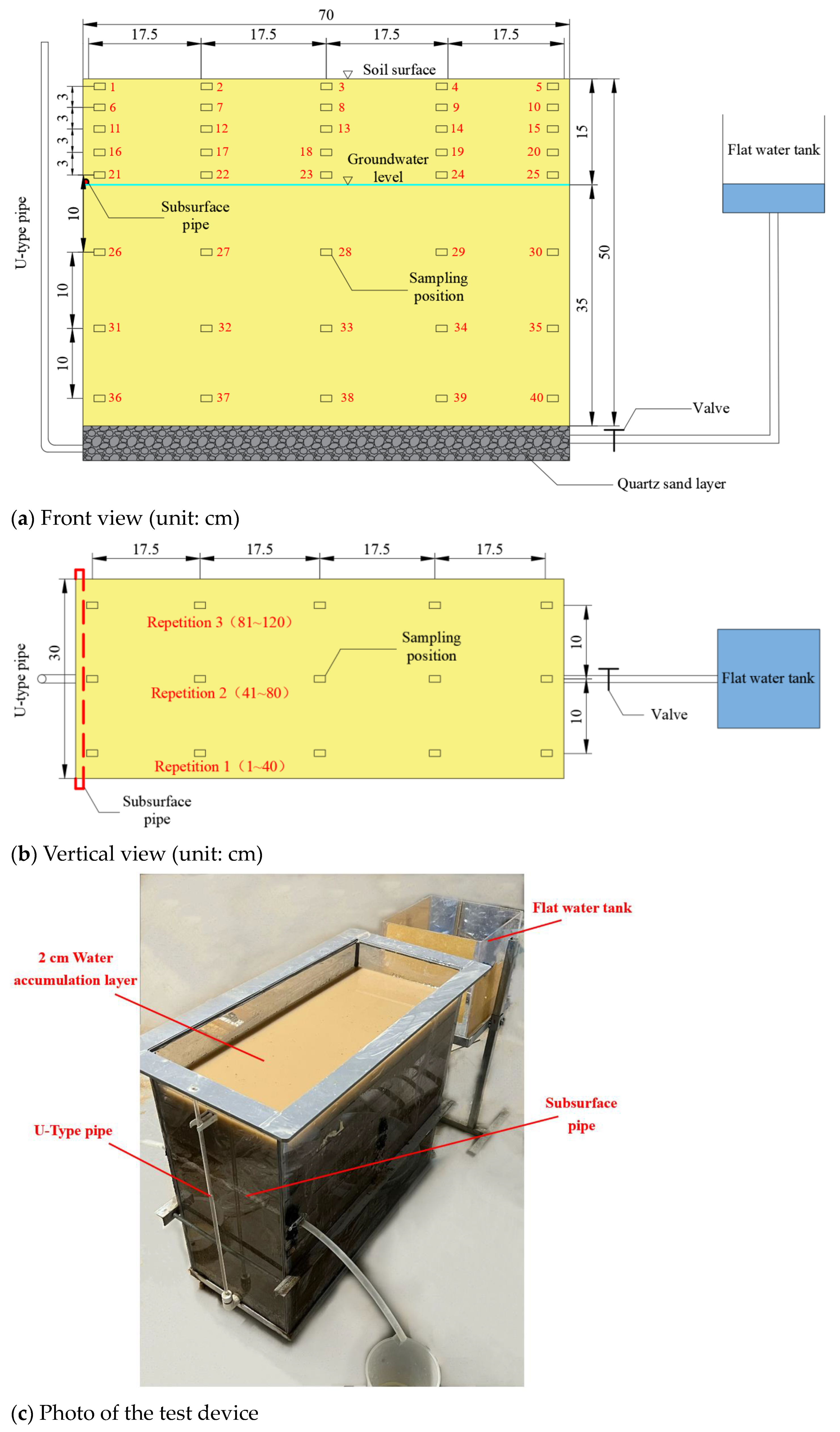
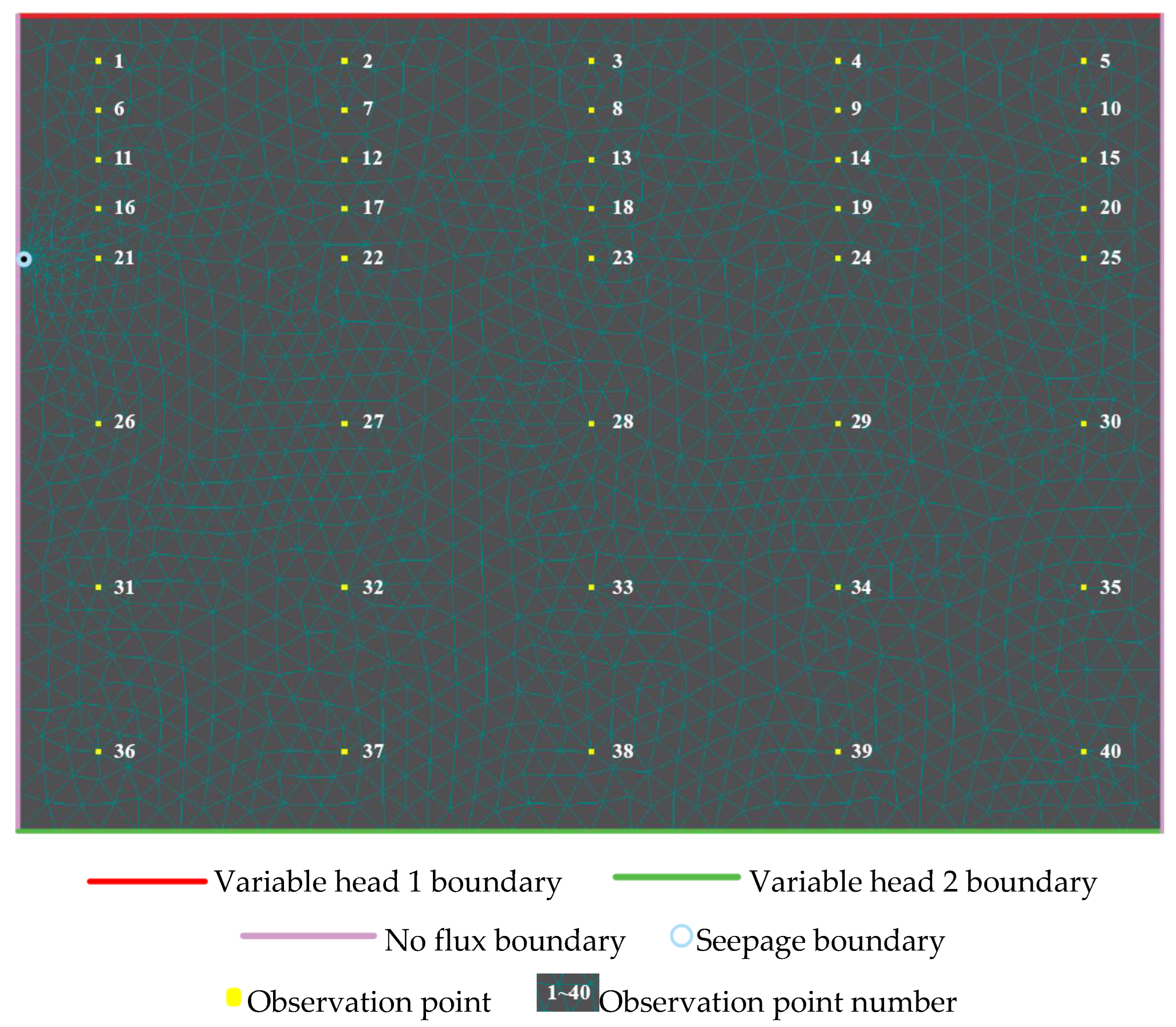

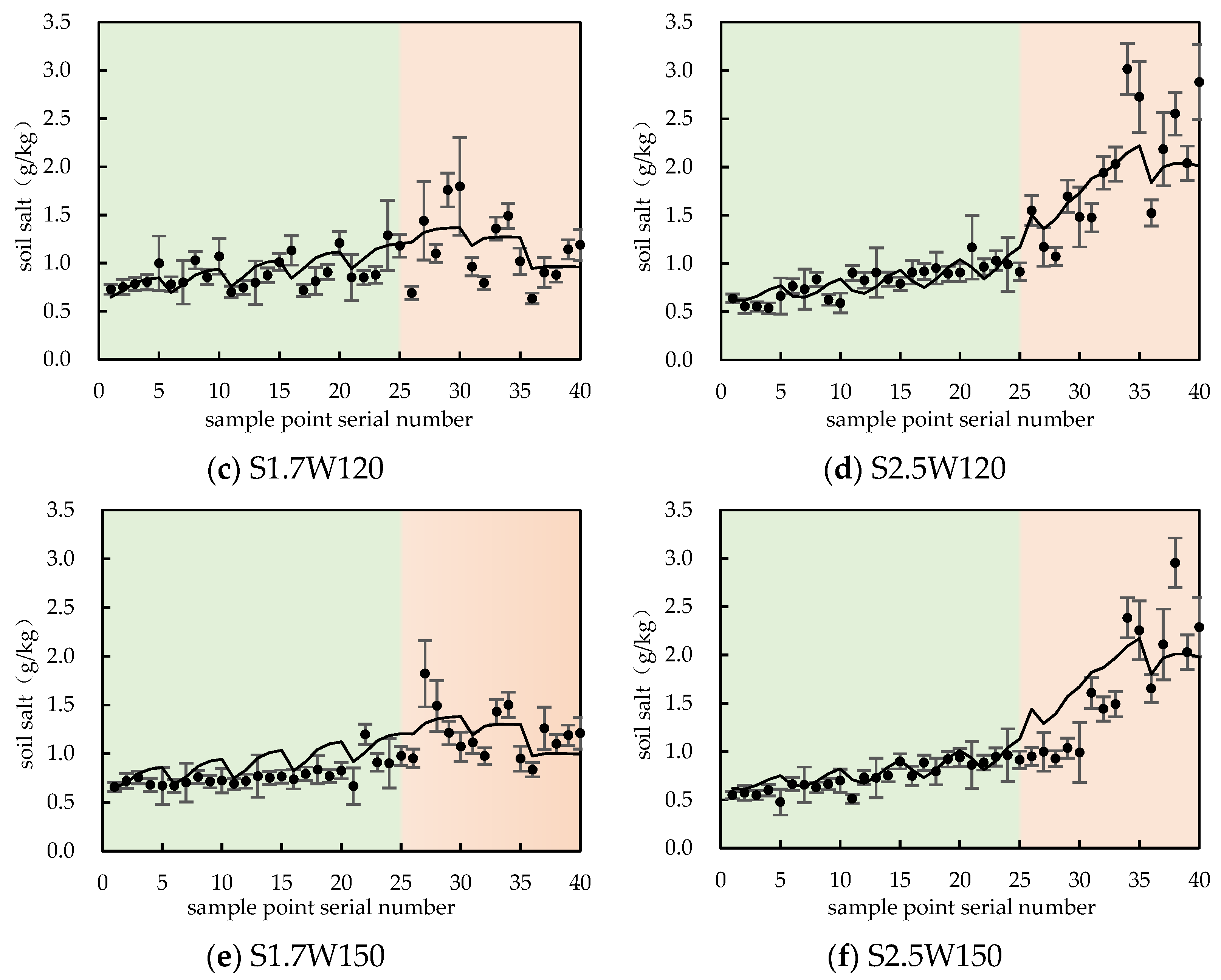
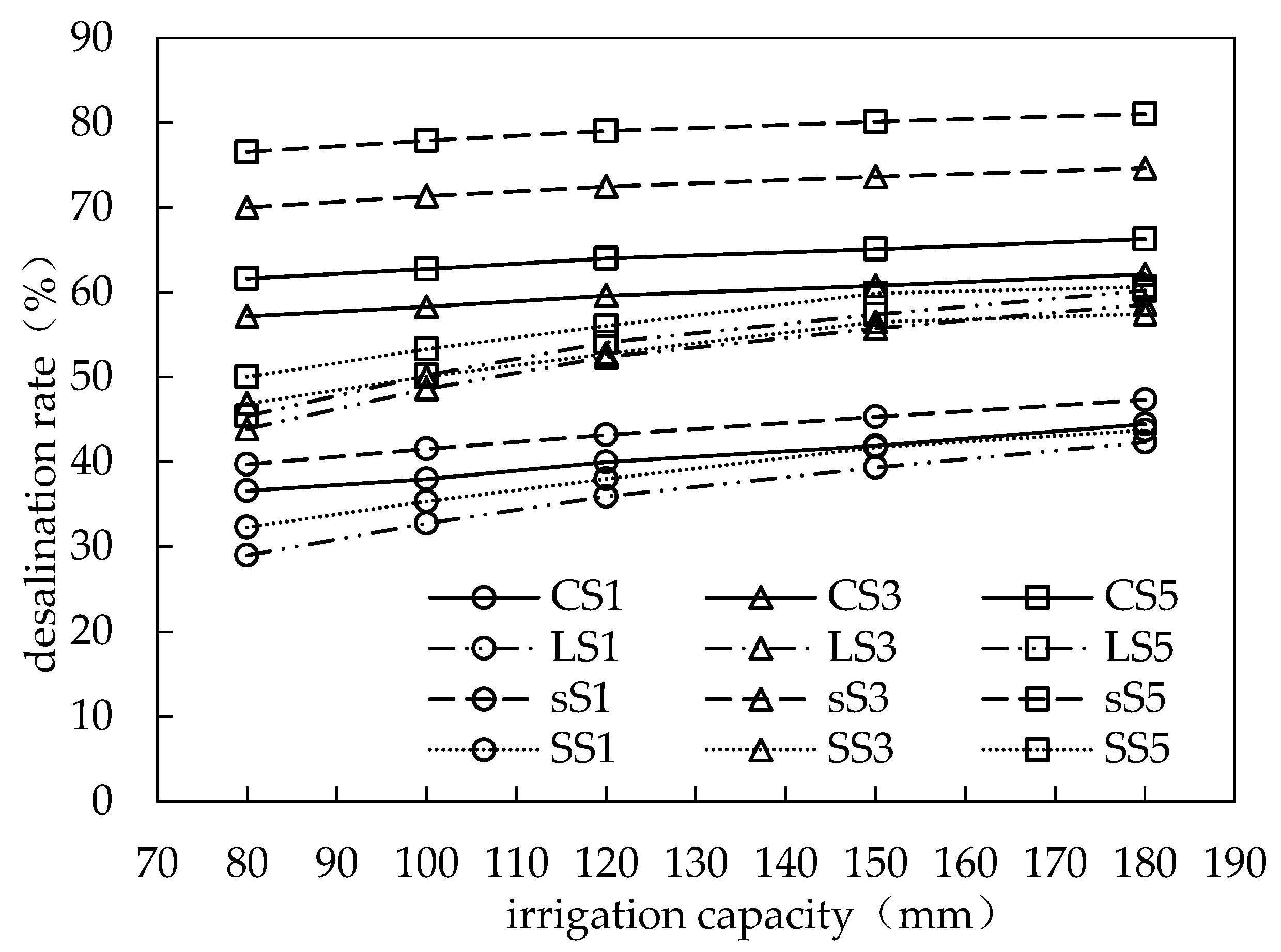

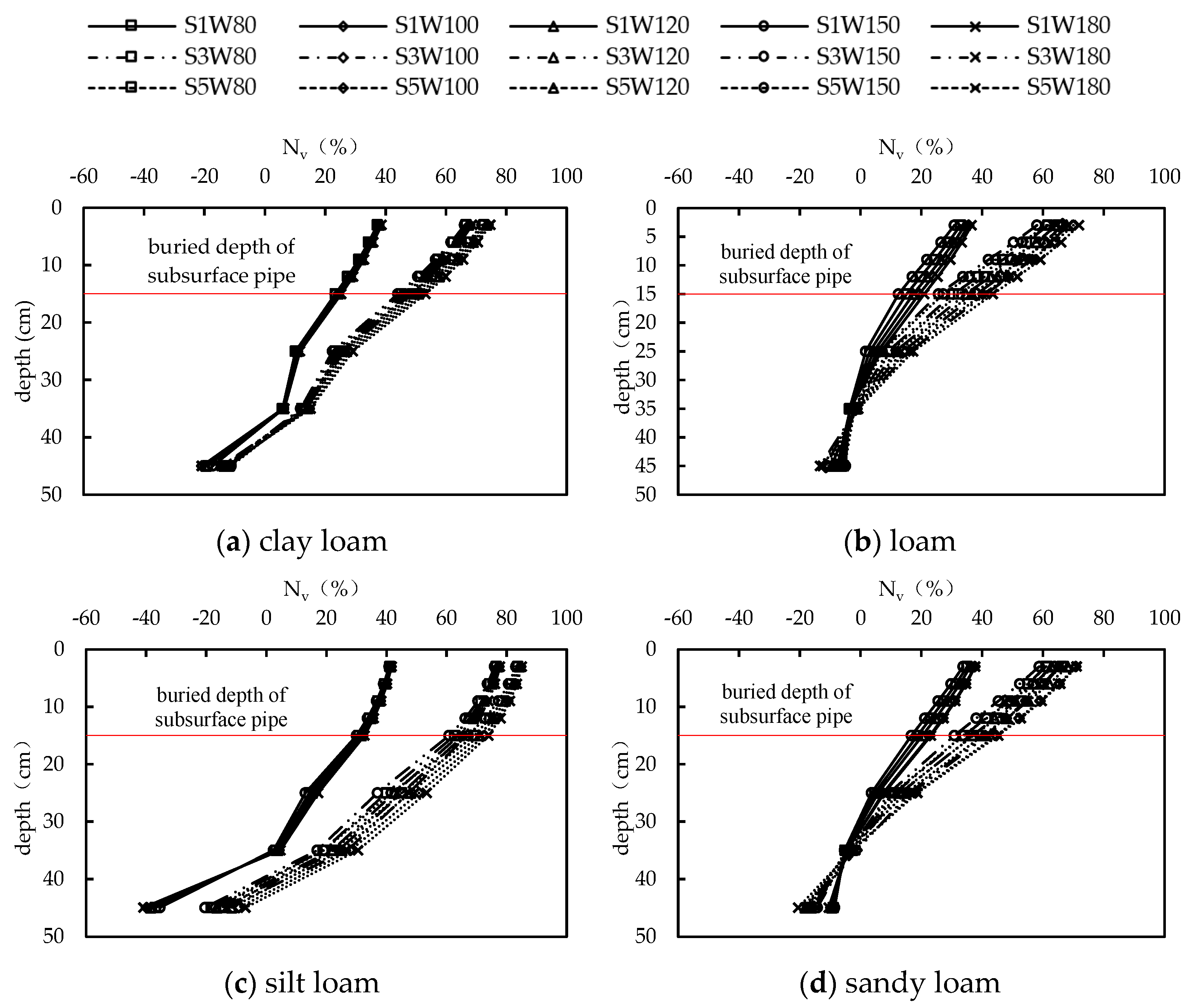
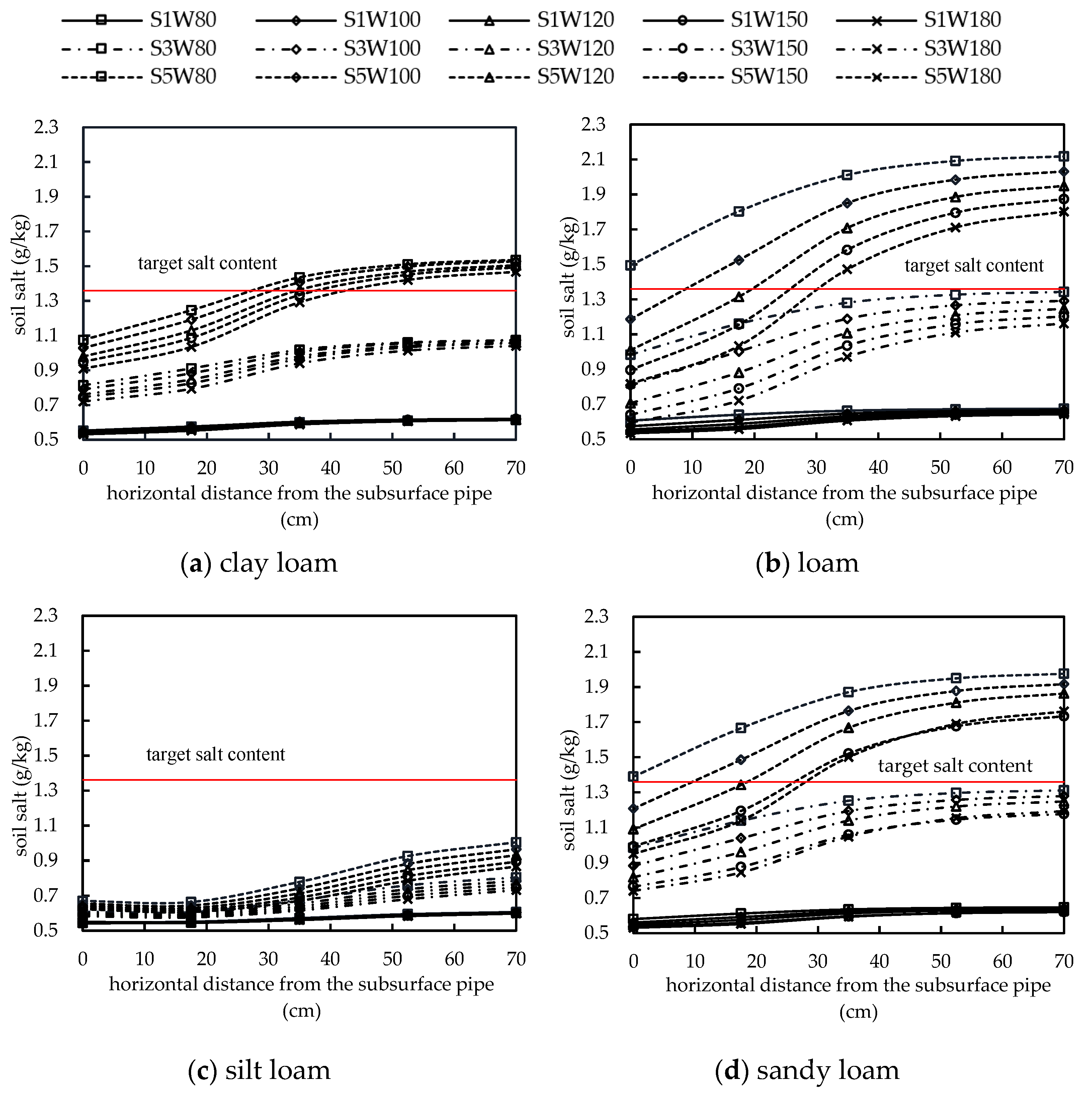
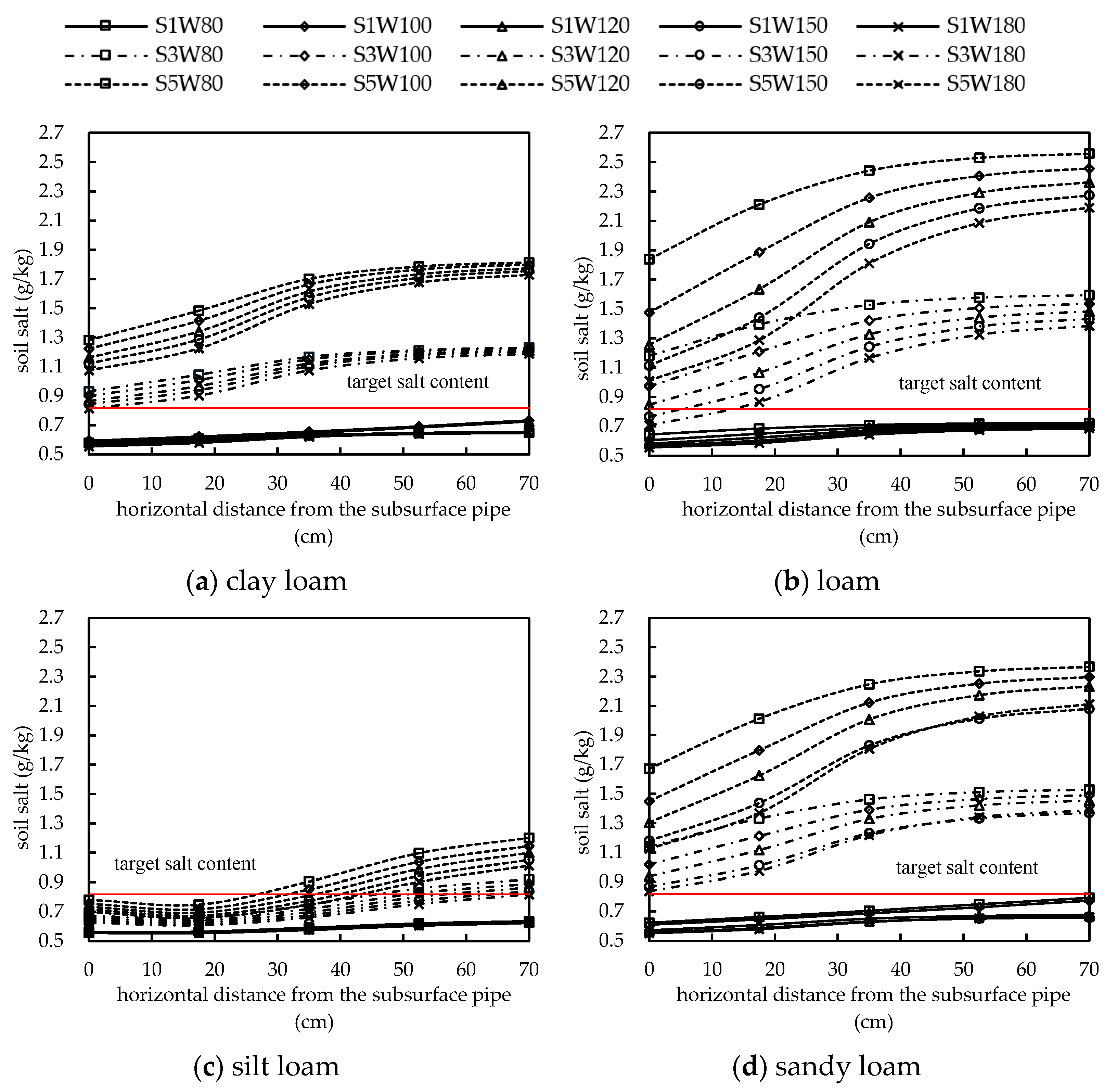
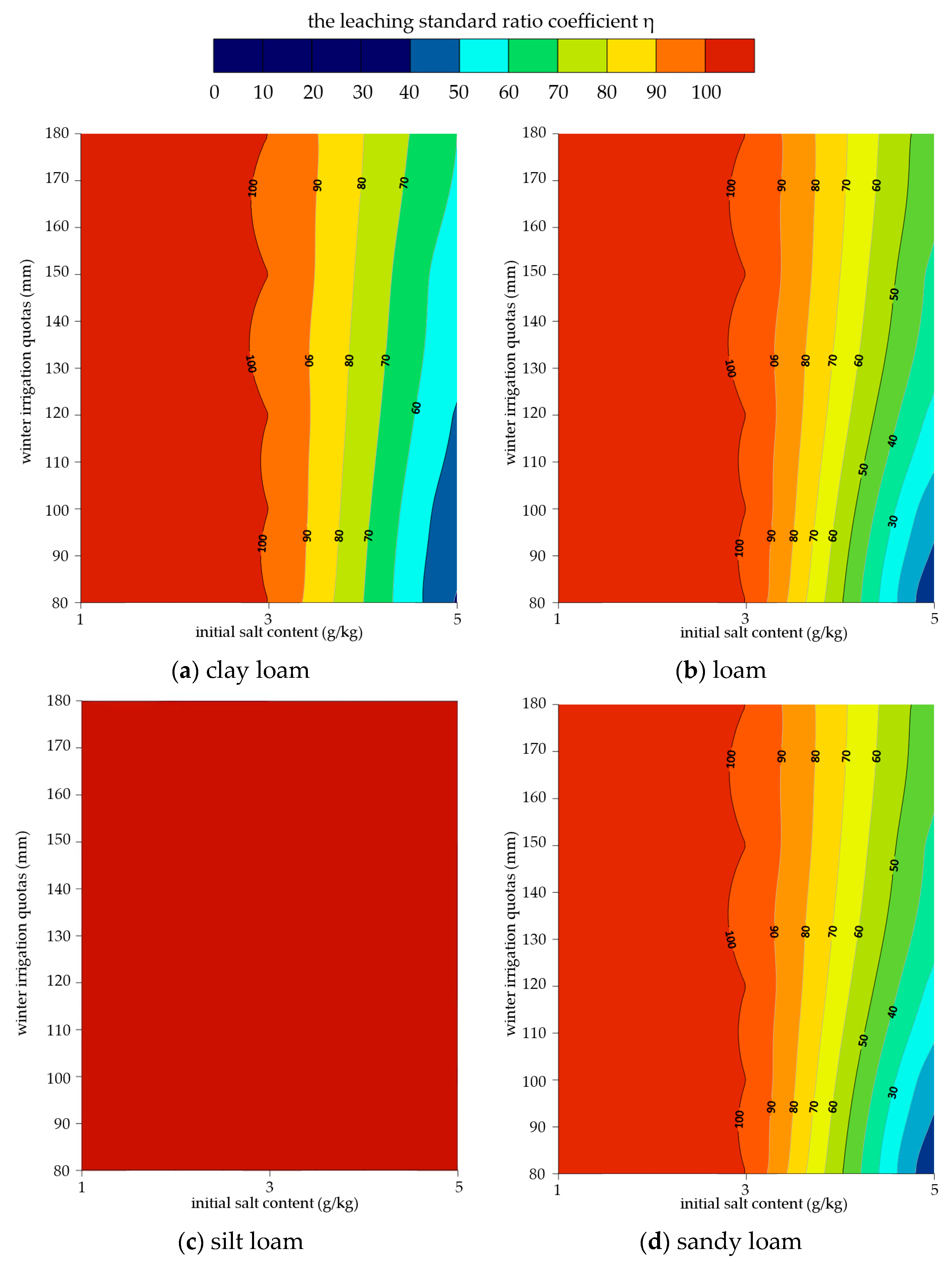

| Test Treatment | Soil Texture | Soil Salt (g/kg) | Irrigation Capacity (mm) |
|---|---|---|---|
| S1.7W100 | Loam | 1.7 | 100 |
| S1.7W120 | Loam | 1.7 | 120 |
| S1.7W150 | Loam | 1.7 | 150 |
| S2.5W100 | Silt loam | 2.5 | 100 |
| S2.5W120 | Silt loam | 2.5 | 120 |
| S2.5W150 | Silt loam | 2.5 | 150 |
| Soil Texture | Particles Content (%) | (1/cm) | (cm/h) | (cm) | (cm) | (cm2/h) | ||||||
|---|---|---|---|---|---|---|---|---|---|---|---|---|
| Clay | Silt | Sand | ||||||||||
| Loam | 15 | 46 | 39 | 0.054 | 0.39 | 0.018 | 1.46 | 2.28 | 0.5 | 9 | 3 | 0.06 |
| Silt loam | 18 | 61 | 21 | 0.065 | 0.39 | 0.053 | 1.36 | 2.13 | 0.5 | 6 | 3 | 0.06 |
| Soil Texture | Initial Soil Salt Content (g/kg) | Irrigation Capacity (mm) | ||||
|---|---|---|---|---|---|---|
| 80 | 100 | 120 | 150 | 180 | ||
| clay loam | 1 | CS1W80 | CS1W100 | CS1W120 | CS1W150 | CS1W180 |
| 3 | CS3W80 | CS3W100 | CS3W120 | CS3W150 | CS3W180 | |
| 5 | CS5W80 | CS5W100 | CS5W120 | CS5W150 | CS5W180 | |
| loam | 1 | LS1W80 | LS1W100 | LS1W120 | LS1W150 | LS1W180 |
| 3 | LS3W80 | LS3W100 | LS3W120 | LS3W150 | LS3W180 | |
| 5 | LS5W80 | LS5W100 | LS5W120 | LS5W150 | LS5W180 | |
| silt loam | 1 | sS1W80 | sS1W100 | sS1W120 | sS1W150 | sS1W180 |
| 3 | sS3W80 | sS3W100 | sS3W120 | sS3W150 | sS3W180 | |
| 5 | sS5W80 | sS5W100 | sS5W120 | sS5W150 | sS5W180 | |
| sandy loam | 1 | SS1W80 | SS1W100 | SS1W120 | SS1W150 | SS1W180 |
| 3 | SS3W80 | SS3W100 | SS3W120 | SS3W150 | SS3W180 | |
| 5 | SS5W80 | SS5W100 | SS5W120 | SS5W150 | SS5W180 | |
| Sample Location | nRMSE (%) | |||||
|---|---|---|---|---|---|---|
| S1.7W100 | S1.7W120 | S1.7W150 | S2.5W100 | S2.5W120 | S2.5W150 | |
| Above subsurface pipe (number 1–25) | 17 | 15 | 21 | 17 | 17 | 13 |
| Below subsurface pipe (number 26–40) | 14 | 25 | 21 | 24 | 22 | 24 |
| All sample (number 1–40) | 15 | 21 | 21 | 24 | 23 | 24 |
| Crop | Soil Texture | Initial Salt Content (g/kg) | H (%) | Appropriate Irrigation Quota (mm) |
|---|---|---|---|---|
| Oil sunflower | Clay loam | 1 | 100 | ≥80 * |
| 3 | 100 | ≥80 * | ||
| 5 | ≥80 | - | ||
| 60~80 | ≥180 *,# | |||
| 40~60 | ≥80 # | |||
| Loam | 1 | 100 | ≥80 * | |
| 3 | 100 | ≥80 * | ||
| 5 | ≥60 | - # | ||
| 40~60 | ≥120 # | |||
| Silt loam | 1 | 100 | ≥80 * | |
| 3 | 100 | ≥80 * | ||
| 5 | 100 | ≥80 * | ||
| Sandy loam | 1 | 100 | ≥80 * | |
| 3 | 100 | ≥80 * | ||
| 5 | ≥60 | - # | ||
| 40~60 | ≥120 # | |||
| Corn | Clay loam | 1 | 100 | ≥80 * |
| 3 | ≥40 | - # | ||
| 5 | ≥40 | - # | ||
| Loam | 1 | 100 | ≥80 * | |
| 3 | ≥40 | - # | ||
| 5 | ≥40 | - # | ||
| Silt loam | 1 | 100 | ≥80 * | |
| 3 | ≥80 | ≥120 * | ||
| 40~80 | ≥80 # | |||
| 5 | ≥80 | - | ||
| 60~80 | ≥180 # | |||
| 40~60 | ≥100 # | |||
| Sandy loam | 1 | 100 | ≥80 * | |
| 3 | ≥40 | - # | ||
| 5 | ≥40 | - # |
Disclaimer/Publisher’s Note: The statements, opinions and data contained in all publications are solely those of the individual author(s) and contributor(s) and not of MDPI and/or the editor(s). MDPI and/or the editor(s) disclaim responsibility for any injury to people or property resulting from any ideas, methods, instructions or products referred to in the content. |
© 2023 by the authors. Licensee MDPI, Basel, Switzerland. This article is an open access article distributed under the terms and conditions of the Creative Commons Attribution (CC BY) license (https://creativecommons.org/licenses/by/4.0/).
Share and Cite
Wang, S.; Mo, Y.; Li, J.; Xiao, J.; Liu, X. Determination of Winter Irrigation Quotas for Corn and Oil Sunflower Considering Crop Salt Tolerance Threshold under Subsurface Pipe Drainage Technology. Water 2024, 16, 72. https://doi.org/10.3390/w16010072
Wang S, Mo Y, Li J, Xiao J, Liu X. Determination of Winter Irrigation Quotas for Corn and Oil Sunflower Considering Crop Salt Tolerance Threshold under Subsurface Pipe Drainage Technology. Water. 2024; 16(1):72. https://doi.org/10.3390/w16010072
Chicago/Turabian StyleWang, Shengjie, Yan Mo, Jingling Li, Juan Xiao, and Xinwang Liu. 2024. "Determination of Winter Irrigation Quotas for Corn and Oil Sunflower Considering Crop Salt Tolerance Threshold under Subsurface Pipe Drainage Technology" Water 16, no. 1: 72. https://doi.org/10.3390/w16010072
APA StyleWang, S., Mo, Y., Li, J., Xiao, J., & Liu, X. (2024). Determination of Winter Irrigation Quotas for Corn and Oil Sunflower Considering Crop Salt Tolerance Threshold under Subsurface Pipe Drainage Technology. Water, 16(1), 72. https://doi.org/10.3390/w16010072






